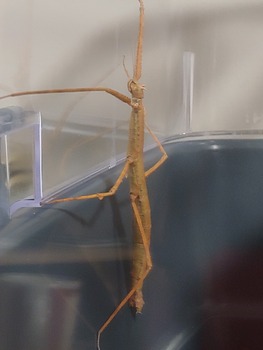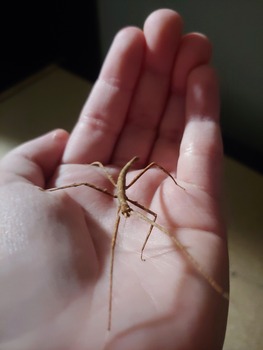Stick insects
Shrines / Stick insects
Welcome to my stick insect page!
About stick insects
Stick insects are insects belonging to the order Phasmatodea. They're found on all continents except for Antarctica, but they tend to be most abundant near the equator. Many species are parthenogenic, meaning females of the species can reproduce asexually, and thus there are some species that are all female. Some species can reproduce both asexually and sexually as well! A stick insect (or a leaf insect, as leaf insects are also members of the same order) may also be referred to as a phasmid.
There is incredible diversity and variation among stick insect species. The smallest species known is about 0.8 inches long, while the largest species known (one that hasn't been been given a scientific name yet at the time of writing this, since we discovered it so recently) can grow up to 25 inches in total length. While all phasmids share similar methods of camouflage and are often unnoticed by predators, some have additional anti-predator adaptations. These include swaying from side to side (to mimic a branch swaying in the wind - this is the origin of the behavior in the "Get stickbugged" meme), flashing bright colors or producing loud noises when startled, imitating ants or scorpions when threatened, swinging legs equipped with sharp spines capable of drawing blood at the threat, releasing defensive secretions, or simply regurgitating their stomach contents to repulse predators.
My stick insects

Otto, my first stick insect.
I got my first stick insect from my brother in June of 2023, as he had two at the time and decided he only wanted one after all - I took the other one. His name was Otto, and since he was already quite old at the time my brother got him, he has since passed away from old age as of September 3, 2023. Though I only got to spend a couple months with him, I miss him quite a lot. While I use he/him pronouns for Otto out of habit, he was a female, since he produced eggs.
Otto left me tons of nymphs, though - a few of these are with my brother now. I hung onto two of them, which passed away from old age as well around February, but left me some eggs before they passed, and I am holding onto one. My partner has affectionately dubbed these nymphs the Ottolettes.
Since stick insects are so short-lived, often only living to a couple of months at most, I doubt I will raise more after this egg hatches (if it hatches).

One of the nymphs - she used to fit on the tip of my finger!
My stick insects are Annam walking sticks, also known as Vietnamese walking sticks (scientific name is Medauroidea extradentata, used to be Baculum extradentatum but the name was changed at some point). This species does contain both males and females, but also has the ability to reproduce through parthenogenesis so females are more common than males. Otto came from a pet store that may have been keeping males in the same enclosure with him, but I am unsure as males are quite rare in the species, and it's unknown how old he was exactly and if he had reached reproductive maturity while at the pet store. I will only know for sure once the nymphs reach adulthood (males of the species are smaller than females and exhibit some other differences in appearance as well... and also they won't lay eggs).
Vietnamese walking sticks are, as their name suggests, native to Vietnam. They're usually about 4 to 5 inches in length as adults. Some sources incorrectly claim that males of the species have wings, but in fact, neither males nor females have wings, unlike some other species of stick insects. Males do, however, have a thinner body than females, and females have two horns on their head while males do not.
In captivity, they can be fed with blackberry/bramble leaves (only the older leaves - newer leaves are not good for them to eat), oak leaves, hawthorn leaves, rose leaves, hazel leaves, and red maple leaves. During the winter, if it is impossible to find even bramble leaves, they can be fed organic romaine lettuce (organic specifically, as otherwise the leaves may have been treated with insecticide or other pesticides). There was actually a study done on diets for the Annam walking stick which showed that organic romaine lettuce is a viable food source during winter. It is, however, best to give them a variety for a balanced diet. From anecdotal reports, it seems they tend to prefer blackberry/bramble leaves. Ideally, leaves shouldn't be collected from right beside a road (they may be contaminated by traffic fumes), and they shouldn't be collected from anywhere you suspect might have been treated with pesticides. I collect leaves from the outskirts of the forest behind my backyard.
Generally, a stick insect's enclosure should be 3 times their length in height (they often hang from the top of their enclosure when molting and having this space is vital to them being able to crawl out of their old skin successfully) and twice their length in both the width and length of the enclosure. If keeping more than one stick insect, it is important to increase the horizontal dimensions of their enclosure.
Some different stick insect species can be kept together (not all), but it is never a good idea to keep stick insects with leaf insects. Leaf insects are especially fragile even for phasmids, and stick insects don't have the braincells required to realize that the thing that looks like a leaf isn't actually a leaf. They will eat the leaf insects. Do not try it.
Annam walking sticks can lay hundreds of eggs across their lifespan, even though they reach reproductive age at 3 months of age and only live for about 5 to 7 months on average. If not disposed of properly, a lot of these eggs will hatch, and they can often overwhelm unexperienced keepers. It's a good idea to search through the enclosure each day for eggs, and to crush them before disposing of them, as unless you live in Vietnam or in the surrounding area, Annam walking sticks are an invasive species (and they also are a little more hardy than other stick insects - it may be possible for their eggs, which take a few months to hatch, to survive a winter, particularly a mild one). This should be done daily for a couple reasons: firstly, they lay a lot of eggs, and secondly, if you crush an egg that has partially developed, you might find the remains of what almost looks like a fully-formed nymph on your hands, and that's a very unsettling experience (I also recommend using tissue paper to crush them, not your bare hands - it will get messy). You can also stick the eggs in the freezer for about a week and then dispose of them, but personally, I prefer to crush them so I know for sure that none of them will hatch.
When nymphs do hatch, they're super tiny, often able to fit on a fingertip, and should generally not be handled unless they walk onto your hand. They can be super fragile. If you really need to handle them, you can do so with the tip of a soft paintbrush. Stick insects usually climb upwards to look for food, so if they seem to not be finding the food you provide, you can try placing them on the plant itself and they usually won't crawl off.
As with other insects, stick insects breathe through what are called spiracles - respiratory openings found on their thorax and abdomen. This means, especially with nymphs, that it is very important to make sure there are no sources of water that they can fall into (they are too stupid to climb out even if that is possible and will drown). Water can be provided by misting the leaves they feed on, which also provides the benefit of keeping the humidity in their enclosure high so that they can successfully molt. Humidity should not be too high, though, as that can lead to the growth of mold and fungus, and stick insects can suffer from fungal infections. How often to mist the enclosure might vary, but as long as the insects are molting successfully, their skin doesn't look cracked or dry when viewed up close, and there's no mold growth in the enclosure, you're probably misting it a good amount and should keep doing what you're doing. If they're having issues molting or their skin looks cracked or dry, increase misting frequency. If there's any mold growth, decrease misting frequency (and also clean their enclosure immediately).
Stick insects may occasionally lose a leg or two during molts (or have one leg come out of the molt looking a little funny). This is usually not a problem, as they will regain it during the next molt (unless they're done molting, in which case they'll probably function fine without the leg anyways). If the insect has their mobility affected by the loss of their legs, that's where it becomes an issue.
Stick insects should also be handled with care to avoid having them lose legs due to improper handling. Generally, avoid grabbing them. Instead, put your hand in front of them and wait for them to walk onto it. They may choose to avoid walking onto your hand, and that's also fine. Otto only ever walked onto my hand three times in total.